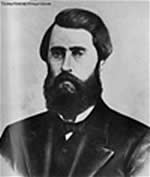
Lesson Eight: Settlement of the Oregon Boundary Question, 1818-1846
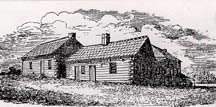 Jason Lee, (left). (Dorothy O. Johansen and Charles Gates, Empire of the Columbia. New York, 1957. Plates following p. 160. Photo courtesy of Special Collections, University of Oregon Library, Eugene.)
Jason Lee, (left). (Dorothy O. Johansen and Charles Gates, Empire of the Columbia. New York, 1957. Plates following p. 160. Photo courtesy of Special Collections, University of Oregon Library, Eugene.)
Jason Lee's "First Oregon Mission" at the edge of French Prairie in the Willamette Valley (right). (Charles Wilkes, Narrative of the United States Exploring Expedition. Vol. 4. Philadelphia, 1845, 374. Drawn by A. T. Agate.)
British and American Activities in the Pacific Northwest, 1818-1848 |
The Convention of 1818, resolving territorial disputes following the War of 1812, authorized a "joint occupancy" of the Pacific Northwest whereby the rights of both British subjects and American citizens to "occupy" and trade in the region were recognized. The British North West Company of fur traders remained the best established colonizing power in the region. The merger of the Hudson's Bay Company and the North West Company, in 1821, brought the American Northwest and Canadian West into the domain of the HBC, a successful fur-trading company that, over time, also developed other extractive resources in the region. The well-capitalized and shrewdly managed HBC dominated non-native society in the region between 1821 and 1840, mainly through the designs of George Simpson. American interest in the Pacific Northwest was sustained by a variety of individuals visiting the region in the 1820s and 1830s. Mountain man Jedediah Smith traveled to the area in 1829. Booster Hall Jackson Kelly came in 1832, although he did not require a visit before promoting the Oregon country to U.S. citizens. American missionaries arriving during the mid- and later 1830s included Jason Lee (1834), Marcus and Narcissa Whitman (1836), and Henry and Eliza Spalding (1836). These individuals did not represent substantial institutional power, but their labors kept alive the idea of an American Northwest. The overland migration of Americans to Oregon began in earnest in the early 1840s. In 1840 there were about 150 Americans residing in the Oregon Country. By 1845 there were 5,000 or more U.S. settlers, most of them clustered in the Willamette Valley (see illustration below). Most had arrived by way of the overland trail, and thus ushered in a new and epic means of cross-country travel. The sudden growth of a resident U.S. population, and of settlers rather than fur traders, altered the balance of power in the area that would become U.S. territory. In 1842, anticipating the possible loss of much of the Oregon Country to the U.S., Simpson consolidated HBC operations northward by shifting the Columbia Department's base from Fort Vancouver on the Columbia River to Fort Victoria on Vancouver Island. In 1843-45, American settlers established the Oregon Provisional Government in order to provide an American system of laws and principles for their growing society. In 1846 Britain and the United States signed the Oregon Treaty, extending the international border between the U.S. and what would become Canada along the 49th parallel to the Strait of Georgia, and then out the Strait of Juan de Fuca. This agreement resolved one "contest" for the region by dividing it between the British and the Americans. Thereafter, such questions as Indian and land policies on either side of the border would be determined by different systems of government. The HBC long remained influential in British Columbia. |
To establish itself as a nation and assert its borders and control over territory, the United States had to accomplish two things. First, it needed to dispossess and displace native peoples, and extinguish their claims to land. The last lesson offers examples of that process beginning to work (albeit under British rather than American influence) among Indians of the Pacific Northwest. Second, it needed to interact with other non-native powers, particularly the nations of Europe, to define and defend American claims to territory. Some times this interaction was peaceful, and some times it was not. Most American territory came into the nation's possession via wars or purchases. Thus the Revolutionary War produced most of the territory east of the Mississippi River and the war with Mexico between 1846 and 1848 incorporated the Southwest, while the Louisiana Purchase in 1803 brought most of the lands between the Mississippi and the Rockies into the nation, and a deal with Russia in 1867 procured Alaska.

Oregon City, sketched as the "American Village" by Captain Henry J. Warre. (Reproduced in Henry James Warre, Sketches in North America and the Oregon Territory. London, 1848. Plate 9.) Courtesy University of Washington Special Collections.
The territory that became the American Northwest was appended to the nation in somewhat unusual fashion, by comparison. First it passed through a phase during which the main two non-native claimants, Britain and the U.S., agreed to share it for an indefinite time—the so-called joint occupation. Second, national ownership of the area was resolved not by war or purchase but by treaty, as the two sides negotiated a boundary dispute. The dispute on the Pacific coast, settled in 1846, was complemented by one on the Atlantic coast, resolved in 1842, between Maine and Canada. Both sets of negotiations were part of the process whereby Britain and the United States reached a more substantial accommodation with one another, after the conflicts of the American Revolution and War of 1812.
The Pacific coast area in dispute, called the Oregon country, stretched from the crest of the Rockies in the east to the ocean in the west, and from the 42nd parallel in the south (today's California-Oregon border) to the parallel of 54 degrees, 40 minutes in the north (today's Alaska-British Columbia border). This territory was claimed by the various explorers who arrived first by sea and then by land. At different times, then, Spain and Russia were among those contesting the region, but between 1818 and 1824 the Spanish and Russians relinquished their claims to the territory south of Alaska and north of California. Thereafter, only Great Britain and the United States, among the developed nations, competed for the Oregon Country.
It should be noted that while Great Britain and the United States both had claims to the entire Oregon country, the two sides mostly expected to divide the territory between themselves; neither could realistically expect to acquire the entire Oregon Country. East of the continental divide, the U.S. and Britain had agreed upon a border running west from the Great Lakes at the 49th parallel. Virtually from the start of discussions over Oregon, the British expected this border to continue west to the Columbia River, and then to follow that river to the ocean. They were willing, in other words, to concede everything south of the 49th parallel, and then south and east of the Columbia River, to the United States. But they wanted to maintain access to the river itself, which after all was the key artery of travel within HBC holdings, and they wanted control over Puget Sound, which they rightly regarded as a superior harbor. At the same time, the Americans generally did not expect to gain anything north of the 49th parallel, but they coveted Puget Sound and access to the Strait of Juan de Fuca. Keep in mind that during the 1820s and 1830s the United States had no good harbor on the Pacific coast. San Diego and San Francisco were first Spanish and then Mexican ports. The shoreline of Oregon offered no great harbor for ships, and the bar at the mouth of the Columbia was notorious for interfering with transportation between ocean and river. Until the conclusion of war with Mexico, 1846-48, the U.S. regarded Puget Sound as the best place for it to acquire a protected, deep-water harbor on the Pacific coast.
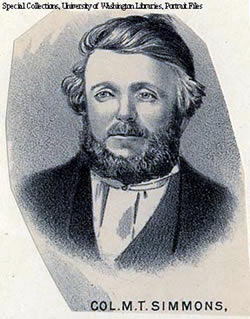
Michael T. Simmons, one of the first settlers of Oregon Territory north of the Columbia River. (University of Washington Libraries Special Collections, Portrait Files.)
Basically, then, the boundary dispute between Britain and the U.S. revolved around which side would get the Puget Sound country and the remainder of Washington state west and north of the Columbia River. In this competition, the British initially had by far the strongest hand. The Englishman George Vancouver, after all, had been the first non-native to discover and explore Puget Sound. And British fur traders, particularly in the employ of the HBC, had in the course of organizing the entire region into an economy of extractive resources, set up permanent bases in western Washington. By the 1830s the HBC had established posts at Fort Vancouver and Fort Nisqually and along the Cowlitz Rover, and they had also developed cordial relations with Indians. Many of George Simpson's designs for the Columbia Department between 1824 and 1840 had been based on the assumption that the British would retain western Washington and lose eastern Washington, Oregon, and Idaho. Thus Simpson had, for example, encouraged American missionaries to set up operations south and east of the Columbia; accepted settlement by American citizens in the Willamette Valley; and tried to extinguish fur supplies in the lands he expected the British would not retain. He believed until the early 1840s that the British would hold on to western Washington, which he regarded as integral to HBC operations on the west coast, and thus did not expect to have to modify activities there in response to an American takeover. Simpson's decision to relocate the Department's headquarters in 1842 from Fort Vancouver to Victoria, however, signaled a change in his thinking. By that time, the balance of power between the British and Americans in regard to the boundary dispute was shifting.
When the U.S. initially agreed to the idea of joint occupation in 1818, it did not really have the resources to make a strong imprint on the Pacific Northwest. It had neither a navy as powerful as Britain's nor a colonizing agent as well-organized and focused as the Hudson's Bay Company. The great majority of its population resided far to the east of the Mississippi River. Its fur traders and trappers had not, until the 1820s, penetrated the Rockies successfully or found ways through the mountains to the west coast. Some Americans nurtured the idea of a Pacific-coast harbor, but most did not envision the United States expanding its holdings beyond the continental divide.

Champoeg in 1851, (right) looking south.
This situation began to change during the 1830s and 1840s. Mountain men and missionaries began to link the Pacific Northwest to the eastern states through their travels to, working in, and descriptions of the region. Moreover, a few parties of settlers began to make their way into the area. Then, during the 1840s, the United States became keenly interested in westward expansion—so interested that national politicians took up the West as a key campaign issue and the U.S. annexed Texas and went to war with Mexico for the remainder of its northern holdings (what became the American Southwest). Simultaneously, thousands more Americans decided to migrate overland toward the coast, including especially the Willamette Valley. American interest in the Pacific Northwest, after about two decades of stagnation, suddenly climbed dramatically, taking the form of both settlers arriving to reside in the region and politicians and statesmen willing to confront the British in order to resolve the boundary dispute in the Americans’ favor. By contrast, British interest in the Northwest remained limited, largely because the HBC monopoly in the area had precluded much attention by others from Great Britain. American citizens were taking a keen interest in the far corner of the continent, while British subjects most likely knew little about it, or else resented the fact of that the HBC was a monopoly.
The arrival of American settlers cast into bold relief the different approaches adopted by the British and Americans for colonizing the region. British colonization proceeded through the Hudson's Bay Company, whose corporate operations focused on extraction of natural resources. The HBC generally discouraged settlement in the lands it expected to retain, and discouraged private ownership of lands; it aimed to minimize any disruption to the fur trade and any dislocation of its Indian trading partners. It also worked to control non-native society in the area so that the company, and not individuals, dominated the local economy and governed the region. Americans, by contrast, expected to bring to the Northwest the more individualistic and democratic attitudes of their society. They insisted upon acquiring privately owned parcels of land and having a voice in government. And they did not wish to be subordinate to such a powerful firm as the HBC. One HBC official summarized the differences nicely: farms in the Willamette Valley, he explained, could flourish "only through the protection of equal laws [the antithesis of monopoly], the influence of free trade [again, the antithesis of monopoly], the accession of respectable inhabitants [meaning the arrival of families of settlers, as opposed to unattached, male fur traders]...while the fur trade much suffer by each innovation."
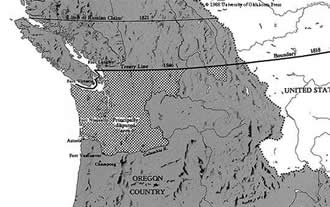 Map of International Rivalries, (left).
Map of International Rivalries, (left).
The arriving American settlers were aware of these differences. Although they did a good deal of business with the HBC, and actually benefited from HBC assistance and trade, they also resented the power of the Company. One way to assert their own interests, and try to limit the influence of the company in the region, was for them to organize their own government—an action that reiterated their faith in American values of self-government and republicanism. Borrowing from the Iowa Territory code of laws, Oregon settlers formed the Provisional Government between 1843 and 1845. The first laws provided for the acquisition and secure ownership of land, the holding of elections, and the formation of a militia. Later legislation provided for an executive and judicial branch of government and divided the territory into counties for local administration. Importantly, the Provisional Government outlawed the migration and residence of African Americans—both free and enslaved—to Oregon. In short order, between about 1838 and 1845, the American presence had gone from being minimal to being substantial. This change was an important factor in strengthening the American claim to the territory.At the national level, too, there existed a desire to stake a stronger claim to the Pacific Northwest. Britain and the U.S. had remained in communication about the Northwest boundary, with both sides generally unyielding in their desire to control Puget Sound. Some Americans grew impatient with the dispute, so much so that James K. Polk, when running for president in 1844, declared that he wanted the U.S. to acquire "all" of Oregon, i.e., the entire region between California and Alaska, including present-day British Columbia. Another campaign slogan to the same effect, "Fifty-four Forty or Fight" (which meant that if the British did not yield the entire Oregon Country, up to the parallel at 54 degrees, 40 minutes, the Americans would go to war for it), summarized the aggressiveness of some Americans in this era of "Manifest Destiny." This belligerence came exactly as Britain was growing more inclined to concede western Washington to the U.S., and it actually may have stalled resolution of the dispute. By 1846, nonetheless, the two nations came to an agreement and signed the Oregon Treaty. The United States, patient since 1818, finally secured the Pacific port they had coveted for so long, a port to which they surely had less claim than the British. The British lost western Washington, but retained the interior coastline of the Strait of Georgia and Vancouver Island. The HBC retained the right of navigation on the Columbia and its substantial holdings in what was now American territory. Yet the transfer to U.S. control did not bode well for further operations south of the 49th parallel, and the HBC would eventually sell its interests in the American Northwest and retrench to British Columbia.
Few Americans today pay much attention to the Oregon Treaty of 1846.The nation's acquisitions by war have seemed more dramatic, and even its acquisitions by purchase have seemed more memorable. The diplomatic negotiations that produced the treaty perhaps appear dull, as if the two sides finally just arrived at a fair compromise. Maybe there is a sense, too, that the U.S. did not take the far corner of the Pacific Northwest so much from another nation or people as it did from a company, the HBC, whose own operations were inhibiting American-style "development" of the region. It would be best, however, to keep in mind that in Canada, across the border that the Oregon Treaty extended in 1849, feelings are different. There, the Oregon Treaty is often remembered vividly as a loss, and one of many examples of American disrespect for Canadian borders and national integrity. Thus James R. Gibson, a Canadian geographer, writes in Farming the Frontier: The Agricultural Opening of the Oregon Country 1786-1846 (1985):
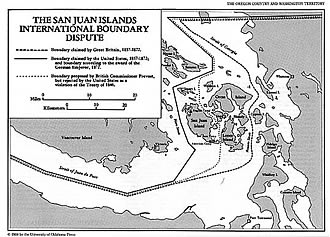
The Oregon Treaty was not a fair compromise; there was no division of the 'Oregon triangle' [the disputed lands in Washington state], all of which went to the United States....Canadians have valid reasons for regretting and even resenting the Oregon settlement, since the British claim to the territory north of the Columbia-Snake-Clearwater river system was at least as good as, if not better than, that of the United States on the grounds of discovery, exploration, and settlement, and since the future Canadian Dominion was deprived of any harbour on Puget Sound....Canadians should not forget that they were dispossessed of part of their rightful Columbia heritage, a heritage whose economic potential in general and agricultural possibilities in particular were initially and successfully demonstrated by the Hudson's Bay Company. They should also remember that whenever it is tritely declared that Canada and the United States share the longest undefended border in the world, it is so mainly because the stronger American republic won its northern boundary disputes at the expense of its weaker neighbour, just as it southern boundary was gained at the expense of a weaker Mexico.
Map of the San Juan Islands International Boundary Dispute, (right).
Gibson's interpretation reflects a longstanding and pervasive Canadian concern about the sheer power of the United States as well as an accurate memory of the many threats that Americans have posed to the integrity of Canadian borders and Canadian national identity. I would, however, add one caveat to Gibson's formulation. When the Oregon Treaty was signed, the Confederation of Canada did not exist; America's northern neighbor was not a nation, but rather several British colonies. When the U.S. negotiated the Oregon Treaty, it did so with Great Britain, not Canada, so it is logical to keep Britain's participation in the treaty in mind (there was as of yet no official Canadian participation in diplomacy). Canadian views of this British participation hint at different kinds of weakness in the face of American strength. Gibson, for example, refers to a British mood of "appeasement" in yielding western Washington to the U.S., while another Canadian scholar (John Saywell, Canada: Pathways to the Present [1994]), recalls not only American aggression but also British carelessness in giving "what is now Washington and Oregon to the United States." American interpretations, by contrast, do not portray Britain as weak, and thus do not tend to see the Oregon Treaty as a deal struck with a "weaker neighbour." Quite the contrary, in fact. In explaining President Polk's decision to accept the 49th parallel as the boundary, Robert H. Ferrell, in American Diplomacy: A History (1975), writes that Polk "had given in to Great Britain [rather than standing up for more territory]. It was one thing to press territorial claims against a nation such as Mexico, and quite another to stand up to the most powerful nation in the world, as Britain was during the nineteenth century."
Canadians and Americans tend to recall the Oregon Treaty in distinctly different ways. In this case and in virtually every other, how one interprets the past depends in large part upon where one is viewing it from.
| Course Home | Previous Lesson | Next Lesson |